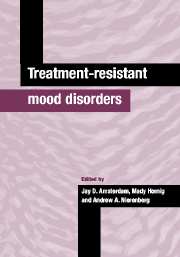Book contents
- Frontmatter
- Contents
- List of contributors
- Preface
- Part I The clinical problem
- Part II Biological basis
- Part III Treatment approaches
- Part IV Special patient populations
- 14 Chronic and refractory mood disorders in childhood and adolescence
- 15 Treatment-resistant depression in the elderly
- 16 Management of treatment-resistant depression during pregnancy and the postpartum period
- 17 Preliminary algorithms for treatment-resistant bipolar depression
- 18 Medical disorders and treatment-resistant depression
- 19 Psychiatric comorbidity in treatment-resistant depression
- 20 Suicide in treatment-refractory depression
- Part V Economic and ethical issues
- Index
- Plate Section
16 - Management of treatment-resistant depression during pregnancy and the postpartum period
from Part IV - Special patient populations
Published online by Cambridge University Press: 25 March 2010
- Frontmatter
- Contents
- List of contributors
- Preface
- Part I The clinical problem
- Part II Biological basis
- Part III Treatment approaches
- Part IV Special patient populations
- 14 Chronic and refractory mood disorders in childhood and adolescence
- 15 Treatment-resistant depression in the elderly
- 16 Management of treatment-resistant depression during pregnancy and the postpartum period
- 17 Preliminary algorithms for treatment-resistant bipolar depression
- 18 Medical disorders and treatment-resistant depression
- 19 Psychiatric comorbidity in treatment-resistant depression
- 20 Suicide in treatment-refractory depression
- Part V Economic and ethical issues
- Index
- Plate Section
Summary
Introduction
The management of pregnant and postpartum women with major depression may be complicated, especially when pharmacological therapies are involved. Many clinicians will encounter this situation at some point due to the high incidence of major depression during the childbearing years and the growing number of women who plan to nurse. The prevalence of this clinical situation has resulted in the comprehensive review of the available data on the use of psychotropic medications during pregnancy and lactation (Altshuler et al., 1996; Cohen, 1989; Kerns, 1986; Miller, 1991; 1994a; Robinson et al., 1986; Stowe & Nemeroff, 1995a,b; Stowe et al., 1998; Wisner & Perel, 1988; Llewellyn & Stowe, 1998). Numerous confounds in much of this literature make the development of definitive treatment guidelines for this period dificult. The literature on cases of treatment-resistant depression is sparse, requiring empirical interpretation of previous case reports and registries. The proportion of women with major depression in pregnancy or postpartum that are resistant to treatment is unknown, and there are no formal studies on the use of potential augmentation strategies involving multiple medications during pregnancy or postpartum. The lack of information on these topics may be due to a lack of documentation of multiple medication use in the literature. Equally plausible, treatment-resistant depressive episodes during this specific time period may not be identified as such, with professionals and patients more willing to tolerate symptoms without employing more aggressive treatment strategies.
Keywords
- Type
- Chapter
- Information
- Treatment-Resistant Mood Disorders , pp. 321 - 349Publisher: Cambridge University PressPrint publication year: 2001



